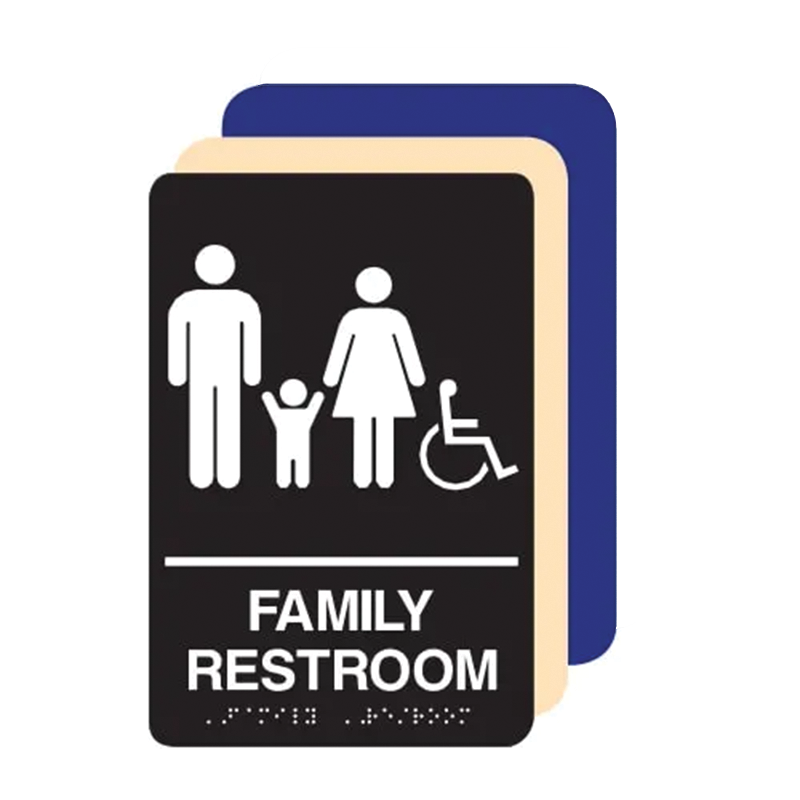Check out the Value of ADA Signs in Public Spaces
Check out the Value of ADA Signs in Public Spaces
Blog Article
Exploring the Key Features of ADA Signs for Enhanced Accessibility
In the realm of access, ADA indicators work as quiet yet effective allies, making sure that rooms are accessible and comprehensive for people with specials needs. By integrating Braille and tactile elements, these indicators damage barriers for the aesthetically impaired, while high-contrast color schemes and clear fonts deal with varied visual demands. Their tactical positioning is not arbitrary but instead a calculated initiative to assist in smooth navigation. Yet, beyond these functions lies a deeper story regarding the advancement of inclusivity and the continuous commitment to developing equitable areas. What a lot more could these signs indicate in our quest of global access?
Importance of ADA Conformity
Ensuring compliance with the Americans with Disabilities Act (ADA) is essential for promoting inclusivity and equivalent access in public areas and offices. The ADA, established in 1990, mandates that all public centers, companies, and transportation services accommodate people with disabilities, ensuring they take pleasure in the same legal rights and possibilities as others. Conformity with ADA requirements not only fulfills legal obligations however additionally boosts an organization's online reputation by demonstrating its commitment to variety and inclusivity.
Among the crucial aspects of ADA conformity is the application of accessible signage. ADA indications are developed to make certain that people with impairments can conveniently navigate via spaces and structures. These indications must follow certain standards concerning size, font style, shade comparison, and placement to ensure exposure and readability for all. Appropriately applied ADA signage helps eliminate obstacles that individuals with handicaps often come across, thereby promoting their self-reliance and self-confidence (ADA Signs).
In addition, adhering to ADA guidelines can minimize the danger of prospective penalties and lawful repercussions. Organizations that fail to follow ADA standards might face lawsuits or penalties, which can be both destructive and monetarily challenging to their public picture. Hence, ADA compliance is integral to promoting an equitable environment for everybody.
Braille and Tactile Aspects
The consolidation of Braille and responsive components into ADA signage embodies the concepts of accessibility and inclusivity. It is normally put under the matching text on signs to ensure that individuals can access the details without aesthetic assistance.
Responsive components prolong beyond Braille and consist of elevated personalities and symbols. These elements are made to be discernible by touch, enabling individuals to determine space numbers, restrooms, exits, and various other critical locations. The ADA sets specific standards concerning the dimension, spacing, and positioning of these responsive elements to enhance readability and make certain consistency throughout different environments.

High-Contrast Color Design
High-contrast color design play a pivotal duty in boosting the presence and readability of ADA signage for people with visual disabilities. These plans are crucial as they maximize the difference in light reflectance between message and background, guaranteeing that signs are quickly noticeable, also from a distance. The Americans with Disabilities Act (ADA) mandates using details color contrasts to suit those with minimal vision, making it a crucial facet of find out this here conformity.
The effectiveness of high-contrast shades exists in their capability to stick out in various illumination problems, consisting of dimly lit atmospheres and areas with glow. Usually, dark message on a light history or light text on a dark background is employed to accomplish ideal contrast. Black message on a white or yellow background provides a plain aesthetic distinction that helps in fast recognition and comprehension.

Legible Fonts and Text Dimension
When considering the style of ADA signage, the selection of understandable typefaces and proper text dimension can not be overstated. The Americans with Disabilities Act (ADA) mandates that font styles need to be sans-serif and not italic, oblique, manuscript, very decorative, or of unusual kind.
According to ADA standards, the minimal text elevation ought to be 5/8 inch, and it must increase proportionally with watching range. Consistency in text size contributes to a natural aesthetic experience, assisting individuals in browsing atmospheres efficiently.
Moreover, spacing in between lines and letters is important to legibility. Sufficient spacing protects against personalities from showing up crowded, improving readability. By adhering to these requirements, designers can dramatically boost access, making sure that signage serves its designated purpose for all people, despite their visual capabilities.
Reliable Positioning Methods
Strategic positioning of ADA signs is crucial for maximizing availability and guaranteeing conformity with lawful requirements. Appropriately located indicators direct people with impairments successfully, promoting navigation in public rooms. Key factors to consider consist of closeness, presence, and elevation. ADA guidelines state that indications should be mounted at an elevation between 48 to 60 inches from the ground to guarantee they are within the line of view for both standing and seated people. This conventional height array is vital for inclusivity, making it possible for wheelchair individuals and individuals of differing elevations to accessibility information effortlessly.
Additionally, indications have to be positioned adjacent to the lock side of doors to allow very easy identification additional reading before entrance. This positioning assists people locate spaces and rooms without obstruction. In instances where there is no door, signs need to be situated on the local nearby wall surface. Consistency in sign placement throughout a center boosts predictability, decreasing complication and improving general customer experience.

Final Thought
ADA indications play a vital duty in promoting availability by integrating features that resolve the demands of people with specials needs. Integrating Braille and responsive aspects ensures critical details is easily accessible to the aesthetically impaired, while high-contrast color design and understandable sans-serif typefaces improve exposure across different lighting problems. Reliable positioning strategies, such as suitable mounting elevations and strategic areas, further promote navigation. These elements jointly cultivate a comprehensive atmosphere, emphasizing the value of ADA conformity in making certain equal access for all.
In the realm of ease of access, ADA signs offer as silent yet powerful allies, guaranteeing that areas are accessible and inclusive for people with disabilities. The ADA, passed in 1990, mandates that all public centers, employers, and transport services fit individuals with impairments, ensuring they delight in the exact same legal rights and chances as others. ADA Signs. ADA indications are made to ensure that individuals with handicaps can quickly navigate via rooms and structures. ADA standards state that signs must be placed at a height between 48 to 60 inches from the ground to ensure they are within the line of view for both standing and seated individuals.ADA signs play a vital duty in advertising ease of access by integrating features that address the requirements of people with disabilities
Report this page